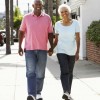Hay muchos factores que pueden contribuir a las razones por las que usted se cae, pero algunos de éstos, los puede cambiar. A continuación le ofrecemos algunos cambios sencillos que puede hacer para reducir el riesgo de caerse.
This 2-page fact sheet is a major revision of the Spanish version of FCS2230/FY736:Fall Prevention: Lifestyle Factors and Fall Risk. Written by Linda B. Bobroff, and published by the UF Department of Family, Youth and Community Sciences, revised April 2016.
http://edis.ifas.ufl.edu/fy860
Tag: Fall Prevention series
Fall Prevention: Lifestyle Factors and Fall Risk
 Many things can cause you to fall. The good news is that you can make some easy changes to decrease your risk of falling. This 2-page fact sheet was written by Linda B. Bobroff and Jennifer Hillan, and published by the UF Department of Family Youth and Community Sciences, October 2013.
Many things can cause you to fall. The good news is that you can make some easy changes to decrease your risk of falling. This 2-page fact sheet was written by Linda B. Bobroff and Jennifer Hillan, and published by the UF Department of Family Youth and Community Sciences, October 2013.
http://edis.ifas.ufl.edu/fy736
Prevención de Caídas: Estilos de vida y riesgo de caídas (FCS2230Span/FY860)
There are many things that may cause you to fall, and you can change several of these. This 1-page Spanish-language fact sheet describes some easy changes you can make to decrease your risk of falling. Written by Linda B. Bobroff y Jennifer Hillan , and published by the UF Department of Family Youth and Community Sciences, May 2011.
http://edis.ifas.ufl.edu/fy860
Fall Prevention: Staying Active (FCS2232/FY738)
Exercises that improve your balance, flexibility, and strength can reduce your risk for falls. This 4-page fact sheet describes exercises that can help you maintain or improve your balance, strength, and flexibility. Written by Sergio Romero and Linda B. Bobroff and published by the UF Department of Family Youth and Community Sciences, May 2011.
http://edis.ifas.ufl.edu/fy738
FCS2228-Span/FY858: Prevención de Caídas: Soluciones para su hogar
Revised! FCS2228-Span, a 3-page fact sheet by Leigh Ann Martin and Emily Minton, is the Spanish language version of FCS2228/FY734 Fall Prevention: Solutions for Your Home. It lists possible hazards in your home for people growing older and modifications that can be made to prevent falls. Includes references. Published by the UF Department of Family, Youth and Community Sciences, July 2010.
http://edis.ifas.ufl.edu/fy858
FCS2227-Span/FY857: Prevención de Caídas: ¿Quién está a a riesgo?
Revised! FCS2227-Span, a 1-page handout by Sergio Romero and Linda B. Bobroff, is the Spanish language version of FCS2227/FY733: Fall Prevention: Who’s at Risk?. It provides a short quiz to determine whether a person is at risk of falling. Published by the UF Department of Family Youth and Community Sciences, August 2010.
http://edis.ifas.ufl.edu/fy857
FCS2231-Span/FY861: Prevención de Caídas: ¡Reduzca su riesgo!
Revised! FCS2231Span, a 1-page handout by Jennifer Hillan and Linda B. Bobroff, is the Spanish language version of FCS2231/FY737: Fall Prevention: Reduce Your Risk!, which tests knowledge of lifestyle factors that can affect the risk of falling using a simple crossword puzzle activity. Published by the UF Department of Family Youth and Community Sciences, August 2010.
http://edis.ifas.ufl.edu/fy861
FCS2228/FY734 Fall Prevention: Solutions for Your Home
Revised! FCS2228, a 2-page fact sheet by Leigh Ann Martin and Emily Minton lists possible hazards in your home for people growing older and modifications that can be made to prevent falls. Includes references. Published by the UF Department of Family, Youth and Community Sciences, March 2010.
http://edis.ifas.ufl.edu/fy734
FCS2229/FY735 Fall Prevention: Home Safety Inventory
Revised! FCS-2229, a 2-page fact sheet by Linda B. Bobroff and Leigh Ann Martin, provides a checklist of changes people can make to reduce risk of falling and keep their home a safe place to live in. Published by the UF Department of Family Youth and Community Sciences, April 2009.
http://edis.ifas.ufl.edu/FY735
